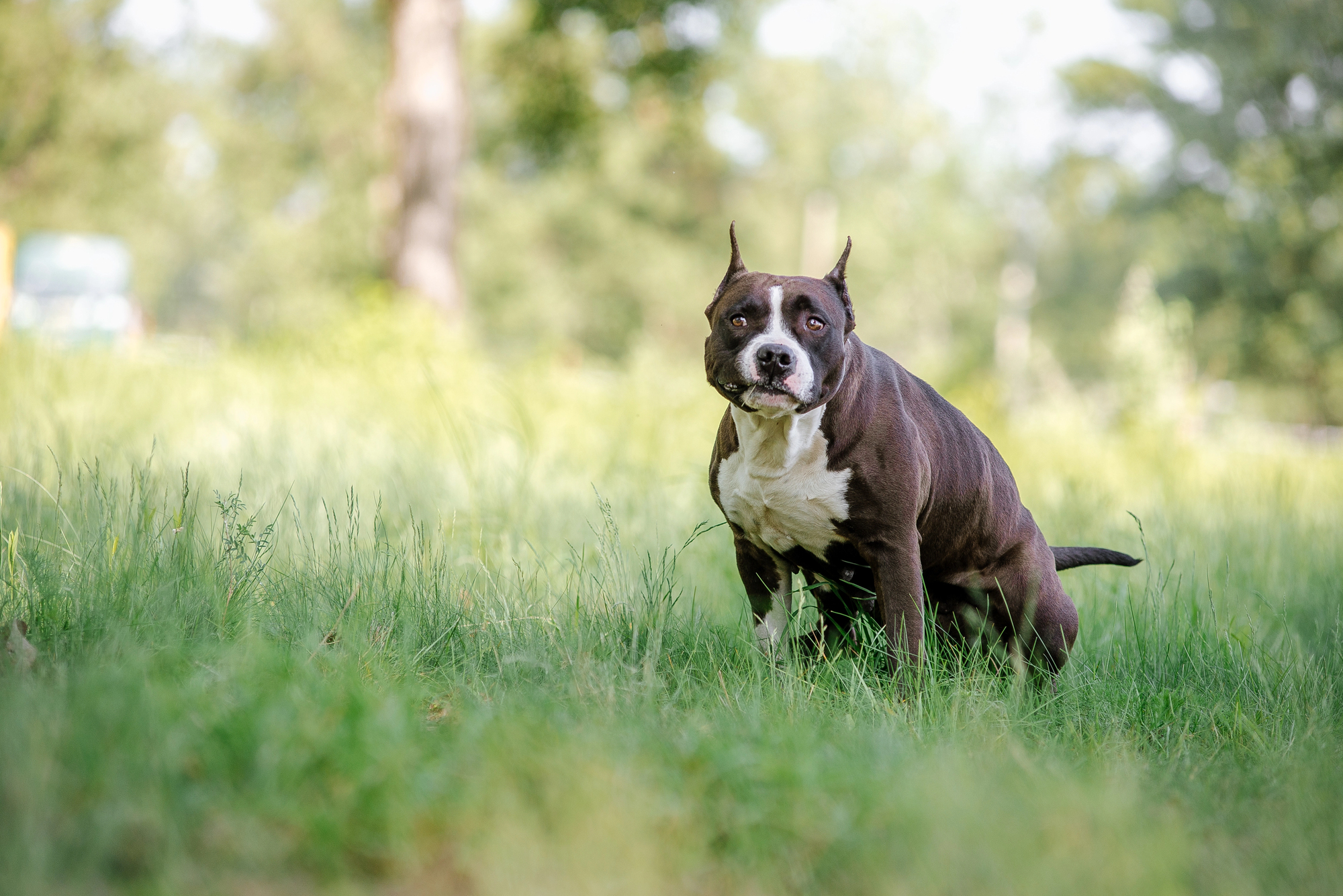
What starts as a normal pet owner chore can become a startling concern. You might take your dog out to do its business, go to scoop up the result and find blood in your dog’s stool. Bloody stool can be a sign that something might be wrong with your pup. While there are no serious reasons for blood in your dog’s poop, it takes a vet exam to determine the root cause and help you understand how to care for your dog going forward.
This guide provides information about the causes of blood in a dog’s stool, symptoms associated with those causes and diagnostic procedures you can expect a vet to use. It also details potential treatments, which tend to be most effective when early intervention is possible.
Types of Blood in Dog Stool: A Visual Clue
Not all bloody stools are the same. There’s a difference between bloody diarrhea and your dog pooping blood, where you see a little blood on the stool. Two major types of bloody stool are described below.
Hematochezia (Bright Red Blood)
This type of bloody stool involves bright red blood that’s fresh. Often, it’s seen on the surface of the dog’s stool and isn’t mixed into it. Typically, this type of blood in dog poop indicates bleeding in the lower gastrointestinal tract, such as in the colon or rectum.
Potential reasons for this type of bloody dog stool include tumors in the lower digestive tract, rectal polyps, colitis, anal sac issues and injuries.
Melena (Dark, Tarry Stools)
When your dog’s poop has signs of older blood, which is typically darker or tarry in nature, it can be an indication that something is awry in the upper gastrointestinal tract, such as the stomach or small intestine. In these cases, the blood you find in your dog’s stool is black and sticky due to being digested.
Some potential causes of this type of blood in your dog’s poop include stomach ulcers, foreign bodies in the upper digestive tract and parasites. Some medications you provide to your dog, even those prescribed by a vet, might also cause these types of issues as a side effect.
The Culprits Behind the Bleeding: Common Causes
While an accurate diagnosis regarding your dog’s digestive system — or other symptoms your dog might be showing — typically requires a vet visit, here are a few common causes for bloody poop from your pet. If you believe any of these might be present in your dog, consider getting to a vet immediately.
Gastrointestinal Issues
Numerous issues can plague your dog’s stomach and cause symptoms such as vomiting, diarrhea and blood in dog poop. Some examples of gastrointestinal issues for dogs include:
- Parasites. The presence of hookworms, roundworms, whipworms or other parasites in your dog’s intestines can lead to bloody stool.
- Inflammatory bowel disease. This condition causes inflammation that can lead to some blood in your dog’s poop. It’s a chronic condition that a vet can manage.
- Viral and bacterial infections. One of the things pet parents should consider is whether their dog is dealing with a virus or other illness that might have come on suddenly.
- Colitis. This condition causes inflammation of the colon, which can lead to bloody dog poop.
- Ulcers. These open sores usually occur in the intestines or stomach and can lead to digested blood appearing in a dog’s poop.
- Presence of a foreign object. If your dog accidentally ingests a bone shard, toy or other item that becomes lodged somewhere in the digestive tract, it can cause an internal injury that results in pooping blood.
- Hemorrhagic gastroenteritis. This serious condition can lead to bloody diarrhea and needs treatment immediately.
- Intussusception: When this occurs, one part of your dog’s intestine slides into another part, creating an obstruction of bowel movements.
Other Potential Causes
Other issues that can cause bright red blood or other concerns with your dog’s stool include:
- Cancer. Some types of cancer that can occur in dogs negatively impact the digestive system and can lead to bloody dog stool.
- Anal sac problems. Injuries, infections, abscesses and other issues in this area can cause bloody stools.
- Clotting disorders. If your dog suffers from a clotting disorder such as hemophilia or Von Willebrand’s disease, its blood may not clot well. This can result in blood ending up in the digestive tract.
- Some medications. In certain cases, blood in the stool may be a side effect of medications given to your dog. NSAIDs (nonsteroidal anti-inflammatory drugs) can also cause this issue.

Accompanying Symptoms of Bloody Stool
Bloody dog stool doesn’t typically appear as a singular symptom, especially if there’s an underlying medical issue. Here are some other symptoms you might look for:
- Digestive distress. If your dog is vomiting frequently or you notice blood or foam in the vomit, something might be wrong with your pup’s digestive system. Diarrhea that’s liquid-like, frequent or contains mucus is another sign. If your dog is straining hard to pass dry or packed stool or having less frequent bowel movements than normal, consider consulting a vet.
- Changes in eating habits. While a dog may alter how much it eats as it ages or goes through different seasons, a sudden and unexplained loss of appetite or other changes in eating habits can be a cause for concern.
- Weight loss. Sudden weight loss, especially if it aligns with passing blood, is a concerning sign.
- Lethargy. If your normally energetic, strong dog is lethargic or unable to run and jump as usual, it can indicate veterinary care is needed.
- Signs of abdominal pain. If your dog guards its belly or whimpers when you touch or attempt to touch the area, that’s a communication you should pay attention to as a pet parent.
- Fever. A dog running a temperature can indicate anything from a mild virus to serious liver disease. If your pup has a fever for longer than a day or a very high temperature, seek veterinarian care.
When to Rush to the Vet: Urgency and Emergency
Not every issue requires an emergency vet visit. However, any amount of blood in a dog’s stool warrants a call to your vet, and if you notice even a small amount of bloody stool alongside other symptoms of illness, seek immediate care. If it’s after hours, you should seek care from an emergency vet in urgent situations that involve a lot of bleeding, very dark and tarry stools or signs of shock. Symptoms of shock in a dog can include difficulty breathing, pale gums, rapid heart rate, cold limbs or the inability to stand up independently.
Diagnosis: Unveiling the Underlying Cause
Your vet will ask questions about your pup’s recent health, diet and activity and then perform an exam. They may also order lab tests to check for issues like parasites, assess organ function and rule out chronic conditions. In some cases, X-rays and ultrasounds may be used to check for tumors or inflammation. Endoscopy or colonoscopy procedures might be ordered to learn more about your dog’s digestive and intestinal tracts.
Treatment: A Tailored Approach
Once your vet has some answers, they can create a treatment plan that addresses the root cause of the bloody stool. This might include medications, antiparasitics, dietary changes or surgery. Fluid therapy and pain management might also be recommended to ensure your dog’s comfort.
Prevention: Proactive Steps for Gut Health
To prevent bloody stools, seeing your vet regularly is important to ensure early detection of potential problems. You should also keep up with monthly heartworm protocols, feed your dog a balanced diet and provide a safe environment free of ingestible toxins like rat poison. Avoid giving your pup table scraps as well, as many human foods harm dogs.
A Healthy Gut, A Happy Hound: Your Dog’s Best Friend
Remember, a proactive approach is your dog’s best defense against the unpleasant surprise of bloody stool. By partnering with your veterinarian and staying vigilant, you can ensure your furry companion enjoys a life full of tail wags and zoomies.
For an added layer of protection and peace of mind, consider exploring advanced technology like the Halo Collar 4. With features like GPS tracking, activity monitoring and virtual fence capabilities, the Halo Collar can help you keep a closer eye on your dog’s health and safety, potentially catching issues early on.
Your dog’s health is worth protecting. Ready to give your dog the best? Learn more about the Halo Collar 4 and how it can enhance your dog’s well-being today.





